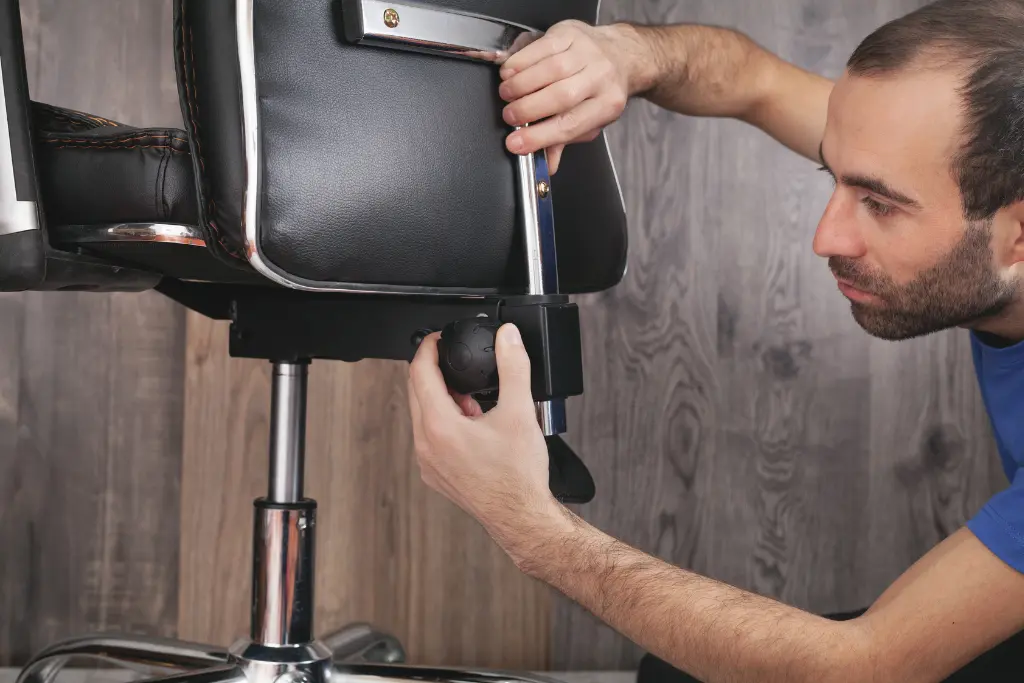Having the right office chair seat angle is crucial for maintaining proper posture and avoiding back pain when sitting for long periods at your desk. In this article, we will discuss the ideal seat angle for ergonomic seating and how to adjust the seat angle on your office chair. We’ll cover common office chair types and provide step-by-step instructions to set the perfect seat angle. By the end, you’ll know how to adjust office chair seat angle for optimal comfort and support.
Understanding the Ideal Seat Angle
Most ergonomic experts recommend a seat angle between 90 to 120 degrees as the ideal range for maintaining an upright yet relaxed posture at your desk. Here’s a breakdown:
- 90-100 degrees: This upright seat angle is suitable for detailed desk-based work that requires visual concentration like typing, writing or designing. It keeps the spine erect.
- 100-110 degrees: This is a slightly reclined angle that provides ample back support. It works well for general computer work, coding, reading or data entry tasks.
- 110-120 degrees: A more reclined seat angle in this range promotes relaxation while still engaging the core muscles. It’s ideal when making calls, having meetings or taking short breaks between work sessions.
- Beyond 120 degrees: Seat angles steeper than 120 degrees are not advisable as they slouch the back excessively and put pressure on the spine over long periods of sitting. Reserve them only for occasional leaning back.
Factors like individual physiology, workload, and preference also impact the ideal seat angle. Adjust the setting based on what provides comfort and supports natural posture for you.
Common Types of Office Chairs
There are a few main types of office chairs that allow seat angle adjustment:
- Manual Adjustment Chairs – These basic chairs have a lever or dial under the seat that manually tilts the angle.

- Kneeling Chairs – Also called kneeling-height or balans chairs. They have a saddle seat that tilts forward to a kneeling position for mobility.
- Ergonomic Chairs – Higher-end chairs with integrated mechanisms and memory foam padding for customizable ergonomic support.
- Mesh Back Chairs – Breathable mesh material keeps you cool with adjustable lumbar and seat angle support.
No matter the type, all good office chairs should have seat angle adjustability within the ideal range between 100 to 110 degrees. Let’s get into the step-by-step instructions to set it properly.
How to Adjust the Seat Angle on Different Chair Types
Identify the Adjustment Mechanism
On most chairs, the seat angle adjustment mechanism will be found either under the front center of the seat or on the outside arms. It may be a lever, dial, or switch. Get familiar with where this is located on your specific chair model.
Manual Adjustment Chairs
- Look under the front center of the seat for a lever or dial.
- Pull the lever up or turn the dial to release the mechanism and tilt the seat backward or forward.
- While holding the lever, tilt the seat to find the 100-110-degree position that feels right for your back.

- Release the lever or dial to lock the seat in place at the new angle.
Ergonomic and Kneeling Chairs
- Look for seat angle adjustment buttons, switches or sliders along the outside arms.
- Press or slide the button/switch to loosen the tilt tension.
- Gently tilt the seat backward and forward to test the different angle positions.
- Once at the ideal 100-110 degrees, release the button to lock it.
- Double-check that the seat doesn’t tilt too easily once locked – it should hold its position but still allow reclining with effort. Let your body weight settle for a minute to ensure everything feels right.
Mesh Office Chair
- Identify the adjustment mechanism. Most mesh chairs will adjust the angle using a tilt-lock lever under the seat or a five-position seat angle knob at the back of the chair.
- Release the lock. For levers, pull it up to release the locking function. For knobs, turn it to the unlock position indicated by markings.
- Tilt the seat slowly. Gently lean back and forth to find your preferred angle within the seat’s range of motion. Go up or down in small increments.
- Lock the angle. Once set, push the lever back down or turn the knob to the corresponding lock marking. Test that it holds firmly.
- Consider mesh stretch. Mesh is elastic and may sag more over time, effectively altering the angle. Tighten or replace if needed to maintain intended ergonomics.
Adjustable Seat Depth and Height
Along with angle, also ensure correct seat depth and backrest height for optimal spinal support.
- For depth, knees should bend at 90 degrees with a few inches of clearance behind.
- For height, adjust the seat so feet sit comfortably on the floor with thighs parallel.
You may need to spend a few days experimenting to figure out the ideal ergonomic settings tailored to your body type and daily activities. And don’t forget to take short breaks every 30-60 minutes to stretch.
How to Tell if the Seat Angle is Correct
- At the proper 100-110 degree seat angle:
- Your thighs and the floor should be parallel to each other.
- Your feet should be fully supported, either on the floor or on a footrest.
- Your back makes slight contact with the chair and is in a natural upright S-curve posture.
- You don’t feel pressure points on the back of your legs or lower back.
Adjusting as needed, continue tweaking the seat angle until you hit the Goldilocks “just right” feeling for your body. Well-seated postures should be sustainable for hours without discomfort.
Additional Tips about How to Adjust Office Chair Seat Angle
Here are some additional tips and details I can provide about adjusting the seat angle on an office chair:
- Testing different seat angles – It’s important to experiment by tilting the seat forward and back within the ideal range to find your perfect position. What may feel right initially could change as your body loosens up.
- Factors that impact ideal angle – Features like seat depth, back angle/lumbar support, and your individual build can necessitate slight adjustments from the generic recommendation. Taller individuals may prefer a slightly shallower angle.
- Frequent adjustments – As we move and shift positions naturally during the day, it’s common for the seat angle to change slightly over time. Make periodic check-ins even if you feel comfortable.
- Broken tilt mechanisms – Older chairs may lose their tilt functions entirely with heavy use over the years. Replacement parts can sometimes be fixed if otherwise in good condition.
Related: How to Fix an Office Chair That Leans Back – A Comprehensive Guide
- Alternating positions – Taking stretch breaks and changing between standing, different seated postures, and walking around helps prevent muscle fatigue from fixed positions.
- Chair quality impacts longevity – Adjustment mechanisms on cheaper chairs wear out faster. Investing in an ergonomic chair designed for long-term use saves money in the long run.
- Consider adjustable lumbar support – This feature mimics the inward curve of the lower back for additional customized support when seated. Works in tandem with seat angle adjustments.
- Seek professional fitting if pain persists – Especially if chronic issues, consulting an ergonomist can uncover any issues treatable by perfecting chair adjustments and workstation setup. Early intervention prevents long-term discomfort.
Final Thoughts
In conclusion, taking just a few minutes to set your office chair seat angle properly can make a world of difference in back health when sitting for work. Adjusting between 100-110 degrees keeps the spine naturally curved and prevents strains from developing over prolonged periods. Don’t forget to occasionally check and tweak the setting as your body shifts throughout the day or week. Maintaining the right chair posture will help you sit comfortably for hours on end without pain.
Frequently Asked Questions (FAQs)
Here are some potential FAQs about adjusting an office chair seat angle, with answers:
Q: How often should I check my seat angle?
It’s a good idea to check your seat angle at least once a week or whenever you start feeling any back discomfort. Our bodies naturally shift positions throughout the day, so small adjustments may be needed periodically.
Q: What if my chair doesn’t recline backward enough?
If your chair only tilts to 90 degrees or less, try raising the chair height slightly by adding a small seat cushion. This simulates more of a backward tilt for your hips. You can also try an ergonomic footrest to take pressure off your lower back.
Q: How do I know if my seat is too far back?
If the seat is reclined too much, over 110 degrees, you’ll feel pressure on the back of your thighs. Your lower back may also slump without support. Your feet won’t touch the floor comfortably either. Play with tilting the seat more upright until those issues disappear.
Q: Can adjusting the seat hurt my back?
As long as you move the seat slowly and stop to test positions, adjusting rarely causes injury. However, if you have existing severe back pain, check with your doctor first before making major changes. Small tweaks are usually safe to find your ideal support.
Q: What if my chair doesn’t adjust at all?
If the chair has no tilt function, try padding or a small cushion to simulate a slight backward angle. Prioritize stretch breaks and varying positions frequently. Consider investing in a new chair that allows adjustment for better long-term posture support.







